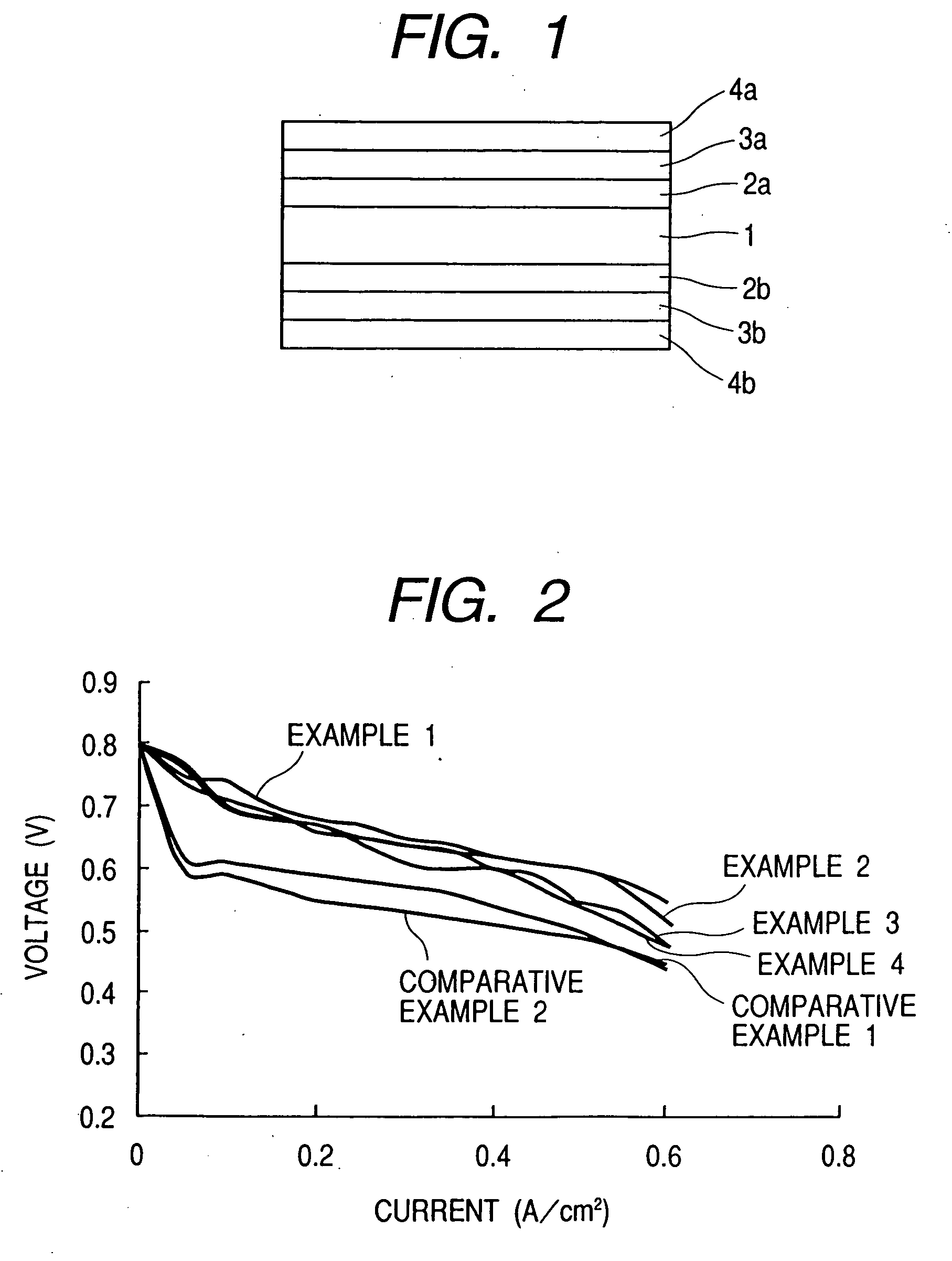Manufacturing process for fuel cell, and fuel cell apparatus
a manufacturing process and fuel cell technology, applied in the direction of cell components, final product manufacturing, sustainable manufacturing/processing, etc., can solve the problems of non-uniform coating, deterioration of catalytic activity, and complex manufacturing process, and achieve the effect of accurate control of catalyst layer coverage and simple pores
- Summary
- Abstract
- Description
- Claims
- Application Information
AI Technical Summary
Benefits of technology
Problems solved by technology
Method used
Image
Examples
production example 1
[0059] Using VULCAN XC72-R (available from Cabot Corporation; average particle diameter: 30 nm) (55% by weight) as the conductive carbon, its particle surfaces were made to carry a platinum (30% by weight)—ruthenium (15% by weight) alloy as the catalyst by the wet process. In order to improve dispersibility, sodium phenylsulfonate was further combined with the carbon particle surfaces by the method disclosed in National Publication No. H10-510862.
[0060] In 10 g of this conductive carbon having the catalyst carried thereon, 50 g of a 5% NAFION-butanol solution (available from Wako Pure Chemical Industries, Ltd.) and 250 g of butanol were well mixed to disperse the former in the latter. Thereafter, the resultant dispersion was mixed with 160 g of water and few drops of a surface-active agent to obtain a electrode catalyst composition.
production example 2
[0061] Using VULCAN XC72-R (available from Cabot Corporation; average particle diameter: 30 nm) (60% by weight) as the conductive carbon, its particle surfaces were made to carry platinum (40% by weight) as the catalyst, and, in order to improve dispersibility, sodium phenylsulfonate was further combined with the carbon particle surfaces, both by the same methods as in Production Example 1.
[0062] In 10 g of this conductive carbon having the catalyst carried thereon, 50 g of a 5% NAFION solution (available from Wako Pure Chemical Industries, Ltd.) and 250 g of butanol were well mixed to disperse the former in the latter. Thereafter, the resultant dispersion was mixed with 160 g of water and few drops of a surface-active agent to obtain a electrode catalyst composition.
production example 3
[0063] Using KETJEN BLACK EC600JD (available from Lion Corporation; average particle diameter: 35 nm) (60% by weight) as the conductive carbon, its particle surfaces were made to carry a platinum (25% by weight)—ruthenium (15% by weight) alloy as the catalyst by the same method as in Production Example 1. Ammonium phenylsulfonate was further combined with this conductive carbon by the method disclosed in National Publication No. H10-510863.
[0064] In 10 g of this conductive carbon having the catalyst carried thereon, 50 g of a 5% NAFION solution (available from Wako Pure Chemical Industries, Ltd.) and 250 g of butanol were well mixed to disperse the former in the latter. Thereafter, the resultant dispersion was mixed with 150 g of water and few drops of a surface-active agent to obtain a electrode catalyst composition.
PUM
| Property | Measurement | Unit |
|---|---|---|
| particle diameter | aaaaa | aaaaa |
| particle diameter | aaaaa | aaaaa |
| particle diameter | aaaaa | aaaaa |
Abstract
Description
Claims
Application Information
 Login to View More
Login to View More - R&D
- Intellectual Property
- Life Sciences
- Materials
- Tech Scout
- Unparalleled Data Quality
- Higher Quality Content
- 60% Fewer Hallucinations
Browse by: Latest US Patents, China's latest patents, Technical Efficacy Thesaurus, Application Domain, Technology Topic, Popular Technical Reports.
© 2025 PatSnap. All rights reserved.Legal|Privacy policy|Modern Slavery Act Transparency Statement|Sitemap|About US| Contact US: help@patsnap.com


